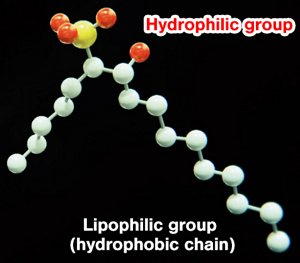Kao Receives the Minister of Economy, Trade and Industry Award in the 20th Green & Sustainable Chemistry (GSC) Awards for the Development of a Sustainable Surfactant Bio Internal Olefin Sulfonate
Kao Corporation (President Yoshihiro Hasebe) has received the Minister of Economy, Trade and Industry Award of the 20th Green & Sustainable Chemistry (GSC) Awards for the feat of developing a sustainable surfactant bio internal olefin sulfonate (IOS). The GSC Awards are presented by the Japan Association for Chemical Innovation (JACI) for outstanding achievements that have greatly contributed to the promotion of GSC, conferring the Minister of Economy, Trade and Industry Award for achievements that contributed to the development of industrial technologies. This is the fifth time that Kao has received this award.
Background and Overview of the Award-Winning Research
The demand for surfactants is expected to increase in tandem with the forecasted increase in the global population and the economic growth among emerging nations. At present, the main raw material of detergent-orientated surfactant is lauric oil/fat with 12 to 14 carbon atoms, which is a miniscule number, some 5% of the ratio contained in all plant oil. These raw materials are coconut oil and palm kernel oil, but as their production centers are limited to tropical regions below the equator, and environmental destruction, such as primary deforestation, is regarded as a problem, there are concerns as to whether stable supply can be maintained.
Here, taking into consideration the likelihood of future shortages of raw material, Kao worked to develop Bio IOS, a surfactant utilizing olein oil/fat with 16 to 18 carbon atoms contained in general purpose palm oil.
<Bio IOS Features>
1. Bio IOS is derived from olein oil/fat with 16 to 18 carbon atoms provided by 95% of all plant oils and fats – furthermore, among those, the solid parts, which are less likely to compete with food applications, are used as the raw material for Bio IOS.
2. Bio IOS is an anionic surfactant that can be synthesized via higher alcohol and internal olefin from the olein oil/fat solid parts.
3. Thanks to a specific structure of long lipophilic group with a hydrophilic group in its midsection, Bio IOS demonstrates superb detergency, as it dissolves easily in water and only requires a small amount to adsorb to oil.
4. A special merit of Bio IOS is that it is highly biodegradable but has low aquatic toxicity.

Bio IOS molecular structure model
Bio IOS is used in the Kao product Attack ZERO, launched in 2019, greatly reducing the environmental load, such as the volume of greenhouse gas emissions* .
Currently, Kao is pushing ahead with collaboration work through open innovation. Thus, via production and marketing of Bio IOS, including in overseas locations, Kao will contribute to the efforts being taken to realize sustainable societies.
-
* Compared to Ultra Attack NEO, Attack ZERO cuts greenhouse gas (carbon dioxide) emissions by 44% (calculation conditions are those for raw material procurement, production and waste disposal stages [but exclude transportation and usage], and the basic unit data for environmental load are taken from MiLCAv2.)

Attack ZERO
Reference: Kao's Award history of the Minister of Economy, Trade and Industry Award of the GSC Awards:
9th Award (FY2009): Industrialization of Surfactant Production Process Synthesized with Subcritical Water
12th Award (FY2012): The Proposal of New Washing Leading the Sustainable Future Society
16th Award (FY2016): Development of the Paper-based Casting Runner
18th Award (FY2018): Development of Water-based Inkjet Ink for Food Package
About Kao
Kao creates high-value-added products that enrich the lives of consumers around the world. Through its portfolio of over 20 leading brands such as Attack, Bioré, Goldwell, Jergens, John Frieda, Kanebo, Laurier, Merries, and Molton Brown, Kao is part of the everyday lives of people in Asia, Oceania, North America, and Europe. Combined with its chemical division, which contributes to a wide range of industries, Kao generates about 1,400 billion yen in annual sales. Kao employs about 33,000 people worldwide and has 130 years of history in innovation. Please visit the Kao Group website for updated information.
Media inquiries should be directed to:
Corporate Strategy
Kao Corporation
